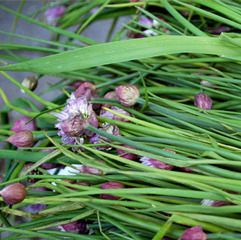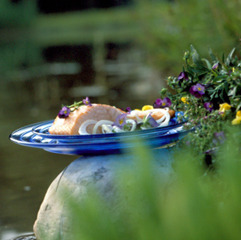Sandra Byrd's Blog, page 23
August 1, 2011
Spring Lettuce with Chive Flowers
 Spring Lettuce with Chive Flowers
Spring Lettuce with Chive Flowers
Serves 6
And I think this word 'sallet' was born to do me good:
Henry VI, Part II, 4, 10
This lemony vinaigrette puree of chives with their springtime purple flowers perfectly compliments delicate pre-summer baby lettuces and herbs.
The original recipe calls for the washed salad greens to be dried "in a strainer". Many of the simple kitchen appliances we take for granted today, like salad spinners, had to be improvised in Shakespeare's day. A whisk was made with thin willow twigs tied together and icing was brushed on with a rabbit's foot or bird's feather. A bale of hay hanging from the ceiling served as a knife holder while quills were used to close the ends of stuffed fish or meats, much as we use toothpicks today.
2 tablespoons freshly squeezed lemon juice
2 tablespoons wine vinegar
3/4 cup extra virgin olive oil
3 tablespoons chopped fresh chives
Salt and freshly milled black pepper
1 cucumber, peeled and very thinly sliced
1 lemon, peeled and thinly sliced
1 cup assorted herb leaves (such as parsley, hyssop, mint, sage, sorrel, or basil)
8 chive flowers
Purée the lemon juice, vinegar, oil, and chives until smooth. Season to taste with salt and pepper.
Toss the cucumbers, lemon slices, and herbs with the vinaigrette, place on a serving platter, and sprinkle with the chive flowers.
Original recipe: To make a sallet of all kinde of hearbes
Take your hearbes and picke them very fine into faire water, and pick your flowers by themselves, and wash them all cleane, and swing them in a Strainer, and when you put them into a dish, mingle them with cuwcumbers or lemmons, payred and sliced, and scrape sugar, and put in Vineger and oyle, and throw the flowers on the toppe of the sallet, of every sorte of the aforesaid thinges, garnish the dish about with the aforesaid things, and hard Egges, boyled, and laid about the dish and upon the sallet.
The Good Husewifes Jewell, 1610 edition of 1587
© Shakespeare's Kitchen: Renaissance Recipes for the Contemporary Cook by Francine Segan.
July 18, 2011
Allington – A Castle for the Ages
 Sandra Byrd
Sandra Byrd
With Kate Eaton
The Medway River flows from the North Sea into the County of Kent in the southeast of England. There on the banks of the River Medway, Allington Castle stands on land once held by the Celts, Romans and Saxons. As early as 1086 there is mention of a manor house at Allington (Elentun) held by Uluric, thought to be the fourth son of Earl Godwin.
Following the Norman Conquest, William the Conqueror's half brother, Odo, Bishop of Bayeux, was awarded the estate, but it was soon transferred to William, Earl of Warren. During his tenure as landowner, a Norman castle was built, probably a stone bailey with a moat. When that castle was ordered destroyed by King Henry II in 1174, a manor house was rebuilt that included dovecotes that remain to this day.
Over the next two hundred years, the castle was improved by successive tenants. When Allington passed by marriage to Sir Henry Cobham in 1309, the impressive Solomon's Tower was added. From then until 1492, Allington stayed by marriage and inheritance in the hands of Penchester descendants. In 1492, however, it was awarded with gratitude by King Henry Tudor to Sir Henry Wyatt, father of Meg Wyatt. Sir Henry had suffered imprisonment and torture in Scotland under Richard III.
As Privy Councillor and executor of Henry's will, he not only helped manage the royal family's affairs during Henry VIII's childhood, he also became an extremely wealthy man. This wealth enabled him to refurbish and expand Allington Castle, adding tall Tudor windows, a large porch, modern fireplaces, an improved kitchen and a courtyard through which England's oldest Long Gallery ran. One of the towers was also torn down and in its place a Tudor dwelling was built. A magnificent, paneled Royal Room was added to house important guests. The public rooms featured high, stone walls and the private lodgings of the family were beautifully furnished with wood-panelled walls and luxurious carpets, tapestries and furniture.
The Wyatt household included two sons, Thomas and Henry, and at least two daughters, Margaret and Anne/Mary. These residents of Allington Castle were deeply enmeshed in the story of Anne Boleyn and Henry VIII. The youngest sister, Meg in my books, was a favorite of Anne Boleyn's and became one of her chief ladies-in-waiting. The two young women had grown up on neighboring estates in Kent and a strong friendship had developed. Meg traveled with Anne to Calais and later served as Mistress of the Queen's Wardrobe andright up through her death. Her sister, Mary/Anne, is also thought to have served Anne as lady-in-waiting.
And, so, to modern times. Today, Allington Castle is owned by an American who is also Chancellor of University of Kent, Sir Robert Worcester and Lady Worcester. Wouldn't it be wonderful to live as they do in a royal castle immersed in centuries of intrigue?
Research Sources: History of Allington Castle, Kent, Sir Robert Worcester, KBE DL
July 10, 2011
Baby Cauliflower in Orange-Lemon Sauce
 Baby Cauliflower in Orange-Lemon Sauce
Baby Cauliflower in Orange-Lemon Sauce
Serves 6
In the original recipe the chef specifies to cut off the cauliflower roots because usually the roots and leaves were cooked with the vegetable.
Taking a cue from the Elizabethans, on both not wasting and on cooking foods in broth, I now save left-over meat scraps and vegetables and tie them into a little sack made with cheesecloth closed with kitchen string. I add this sack to the cooking water for a sort of instant broth and flavor boost when I'm steaming vegetables or cooking pasta or rice.
6 heads baby cauliflower
2 cups chicken stock
Salt
2 tablespoons butter
Zest of 1 lemon
2 tablespoons freshly squeezed lemon juice
Zest of 1 orange
1/2 cup freshly squeezed orange juice
Clean the cauliflower, leaving on some of the green leaves. Bring the stock to a boil in a pot with a steamer insert. Steam the cauliflower for 15 minutes, or until tender, and drain.
Combine the butter, lemon juice, orange juice, lemon zest, and orange zest in a large saucepan and simmer for 3 minutes.
Place the cauliflower in a shallow serving bowl and pour the sauce over the cauliflower.
Original recipe: Buttered Colliflowers
Have a skillet of fair water, and when it boils put in the whole tops of the colliflowers, the root being cut away, put some salt to it; and being fine and tender boiled dish it whole in a dish, with carved sippets round about it, and serve it with beaten butter and water or juyce of orange and lemon.
The Accomplish't Cook, 1685 edition of 1660 book
© Shakespeare's Kitchen: Renaissance Recipes for the Contemporary Cook by Francine Segan.
June 22, 2011
Knights and Ladies
 Sandra Byrd
Sandra Byrd
with Kate Eaton
When you read of 'knights' and 'ladies' in historical novels, do you wonder what, exactly, those terms mean? Here's a quick explanation of how those titles were in play in England during the Tudor years.
During the Middle Ages (500s through 1500s), knighthood was awarded to men who fought well for their monarch's causes. These men were also those who had the means to support the necessities of the noble military class, including horses, armor and servants which could be rallied to the Monarch's military causes.
Another route to knighthood was to follow the Five Steps to Knighthood:
1) Have a connection to a noble family
2) Be trained in chivalry, loyalty to your liege lord and pracice mock battles as a young child
3) Serve as a Page from age seven to fourteen at the castle of another Lord, learning battle skills and serving your training Lord
4) Serving as Squire from the fourteenth year until knighted, learning the social graces required at Court, the art of chivalry and necessary battle skills, and also going to battle with his training Lord
5) Knighthood – could be conferred on a young Squire after exemplary service in battle, or after years of training to become a Knight.
By the time of Henry VIII, knighthood had come to mean an honor conferred to bind a man's loyalty to the monarch. Once a man was knighted, he was referred to by the title 'Sir'. Henry VIII, in particular, limited the ability to award knighthood to the British monarch, as opposed to the earlier practice of military leaders being able to knight a man on the battlefield for exemplary service. "Sir" is normally followed by a man's first name. For example, Anne Boleyn's father was referred to as "Sir Thomas," not "Sir Boleyn."
Knights of the Garter were the most senior men in the realm and Henry VIII greatly expanded the number of those honors awarded during his reign. Another 'chivalric' order of knighthood that King Henry recognized was the Knights of the Bath. Today, that order's thirty-six nobles have banners which are hung in the Henry VII chapel at Westminster Abbey, but during Henry VIII's time it was that group of knights who followed the ancient spiritual and physical cleansing ritual prior to knighthood.
The use of the title Lady, on the other hand, is a bit more complicated. It has been used for centuries in Great Britain to denote nobility. The feminine equivalent to Lord, it can be used by women born into or marrying into noble rank, specifically marchioness, countess, viscountess and baroness. In that case, the woman is referred to as 'Lady' followed by her husband's family name, for example, Lord Thomas and Lady Boleyn. The wife of a younger son in the same family would be known as 'Lady' followed by both her husband's first and last name to avoid confusion with the more noble lady. Noblewomen are only allowed to use their first and last names following the title 'Lady' if they are the daughters of an earl, marquess or duke.
To parallel what we've learned about knighthood, the term 'Lady' is also given to the wives of knights. In that case, the couple would be referred to as 'Sir Henry and Lady Wyatt.' In literature or conversation, however, precise titles may take a backseat to ease of speaking, so that it will be obvious who is being addressed or who is speaking.
Research Sources: Heraldica.org; HeraldicSculptor.com; HMSRichmond.org; Middle-Ages.org.uk
June 7, 2011
Salmon with Violets
 Salmon with Violets
Salmon with Violets
Serves 4
I know a bank where the wild thyme blows,
Where oxlips and the nodding violet grows,
A Midsummer Night's Dream, 2, 1
The beautiful colors, presentation, and wonderful light flavors of this dish typify the sophistication of Elizabethan cuisine. Many types of edible flowers were used in cooking, both for their visual appeal and taste. Flowers were not set out onto the table in vases, but rather the dinner platters and the food itself was considered the decoration. Cookbooks of the time even list instructions on salads "for shewe only" with details on creating large elaborate "flowers" made of various cut vegetables and herbs.
2 tablespoons white wine vinegar
1 teaspoon sugar
1 tablespoon freshly squeezed lemon juice
1/4 cup extra virgin olive oil
Salt and freshly milled black pepper
1 large Vidalia onion, sliced paper-thin
1 salmon fillet, cut into 4 strips (about 12 ounces)
3/4 cup edible violets
Place the vinegar, sugar, and lemon juice in a small bowl and slowly whisk in the olive oil. Season to taste with salt and pepper. Toss the onion in the vinaigrette and set aside.
Preheat the grill. Cook the salmon strips for 3 to 4 minutes on each side, or until firm.
Place a mound of the onion in the center of each plate and top with a piece of salmon. Drizzle the remaining vinaigrette over the salmon and arrange the violets on the salmon and around the plate.
Original recipe: An other [Sallets for fish days]
Salmon cut long waies with slices of onyons upon it layd and upon that to cast Violets, Oyle and Vineger.
The Good Husewifes Jewell, 1587
Taken with permission from Shakespeare's Kitchen: Renaissance Recipes for the Contemporary Cook by Francine Segan.
April 28, 2011
Master Potter
 Master Potter by Jill Austin, a book review by Gail Johnson
Master Potter by Jill Austin, a book review by Gail Johnson
Have you ever thought about how disappointed the Potter must feel when the clay refuses to yield to His design? Or His delight as the vessel submits to the pressure of His hands as He shapes it. I have. The Lord, speaking to Israel through the prophet Jeremiah asks, "O house of Israel, can I not do with you as this potter does?" (NIV) Sounds simple enough until I am placed on the Potter's wheel.
In her book Master Potter, award-winning professional potter, Jill Austin describes the emotional love affair between the Potter and the clay as she weaves the story of Forsaken, a broken vessel living in 19th century Comfort Cove.
In the beginning, Forsaken is hiding in the dreaded Potter's field fighting the demons of her past. When Forsaken contemplates, Master Potter rescues and carries her to His cottage. There He explains to become the vessel He intended her to be He must crush her with Unrelenting Love to remove the brokenness and filth. Afterwards he places her into Abundant Life Falls where she becomes pliable once more and ready for the wheel.
All along the way, Master Potter explains every process and the reason for the procedure. Through it all, He gives Forsaken the "choice" to yield or rebel.
I empathized with her struggles as I recalled the times in my life I had faced the same test. I watched—and understood as she made good and bad choices that shaped and even scarred her life. I cringed as she refused to forgive and took matters into her own hands. So emotionally drawn to this character, I wanted to scream because I knew for every mistake she made there would be a consequence.
Master Potter isn't an easy read. As you read it, it reads you. I was ashamed of my past unwillingness to be crushed, molded, trimmed, and placed in the fire. However just as Forsaken learned, I too have learned when moving forward in my journey I may not always discern the right moves but if I hold to the Potter's hand and listen to His voice then and only then will I become a vessel of honor.
Master Potter truly reminds every reader …O Lord, thou art our Father; we are the clay, and thou our potter; we all are the work of thy hand (Isaiah 64:8).
Age range – Adult
Genre – Historical
Part of a series – Master Potter, book one
Pages – 294
Publisher – Destiny Image
April 7, 2011
Make it So
Possible: May or can be; chance
Probable: Likely; more evidence for than against
Plausible: Seemingly worthy of approval or acceptance
 When constructing fiction, we're building a world that we want our readers to believe is real. The events that transpire – whether or not they are based on things that "really happened," must be believable to the reader. Our events can be: possible, probable, or plausible.
When constructing fiction, we're building a world that we want our readers to believe is real. The events that transpire – whether or not they are based on things that "really happened," must be believable to the reader. Our events can be: possible, probable, or plausible.
Probable events are no brainers – everyone accepts that this is a likely, believable scenario or action and there are no flags raised. The reader continues through the situation without doubt. A certain, few number of possible events are allowed, too. If you don't require the reader to accept more than a few possible events, they will have a firm place in your plotting. But what happens when you need to make circumstances that are possible into those that are probable, in order to solidly advance your story?
You make them plausible. How? Like a lawyer building a case, you show evidence, but you do it without too much fanfare. For example, in my current work in process I want someone to die of smallpox. In order to insure that this death isn't too convenient I mention in passing, early in the book, that smallpox has been on the increase in recent years and sneak in a statistic if I can, in dialogue. Some chapters later, I have a minor character die of smallpox – one who really existed and whom my readers could verify if they wanted to. Later, when I kill someone off with smallpox, I have now taken a possibility and made it plausible by building a case. It may initially raise a flag with my readers, but a quick review of the evidence I've quietly marshaled in passing will convince them that it's probable and they will read on, undisturbed.
April 1, 2011
A Faithfilled Doubt
 There are some teachers you can listed to all day, and X. E. Dixon is one of them. Read on, and see if you don't agree …
There are some teachers you can listed to all day, and X. E. Dixon is one of them. Read on, and see if you don't agree …
I am quick to proclaim my faith, praying for God's help and direction. But sometimes, instead of waiting on Him in the storm, I do whatever I can to ease, and even prevent, my pain or discomfort. It's hard for me to trust that He wants to, or will, do anything at all.
Similarly, in Mark 9:14-29, a heartbroken father approaches Jesus. He shares how his son had been tormented by an evil spirit, suffering from violent seizures since childhood. Then the man makes a bold, yet subtle, statement of doubt as he pleads with Jesus:
"If you can do anything, take pity on us and help us."
"If you can?" said Jesus. "Everything is possible for him who believes."
Taken out of context, this passage has been used to criticize and rebuke people who struggle with worry, doubt, and waiting on God. But, the father's response has much to teach us on how to pray and trust God to work for the good of those who love Him, especially when we don't like His answers. Like me, the father knew enough about Jesus to come to Him. Yet, a part of him wondered if God could really meet his deepest needs, or care about his personal pain. Still, he cries out, "I do believe; help me overcome my unbelief!" And in an act of mercy, Jesus heals the boy, takes him by the hand, lifts him to his feet and helps him stand (v. 27). I understand that tug of war between faith and unbelief.
Releasing my marriage to God was the hardest thing I ever had to do. The Lord worked on my husband and me through the fires of addiction, infidelity, and our habits of unhealthy communication. I spent many years praying, "Lord, help me with my unbelief as You restore my marriage, for Your glory." By God's grace, my husband has stepped up as the spiritual leader in our family. We are celebrating ten years in Jesus, and seventeen years of marriage, in 2011.
There are three things supported by Scripture that I learned from the father in Mark 9.
1. Come to Jesus and be honest about our struggles. (Matthew 11:28)
2. Admit our need for Him to help us with everything, including having faith. (John 15:5)
3. Remain humble and trust His timing, regardless of our circumstances. (Proverbs 3:5-6)
Scripture doesn't share the father's response to this miracle in the Gospel of Mark. But, there's a powerful lesson in the final image of him sinking to his knees before Jesus, admitting his inability to believe without the Lord's help. This is exactly where God wants His disciples, acknowledging our full dependence on Him to be the author and perfecter of our faith (Hebrews 12:2). And no matter what we are going through, we can be sure of two things: Jesus loves us and will walk with us through the valley of faith-filled doubt and onto the plain of victory.
March 30, 2011
Cartoon
March 17, 2011
How Does Your Garden Grow?
 A thoughtful writer – and gardener – Ellen Boyer encourages us to pay attention to the small details in our lives, taking time to plant, and weed, all the way down to the roots.
A thoughtful writer – and gardener – Ellen Boyer encourages us to pay attention to the small details in our lives, taking time to plant, and weed, all the way down to the roots.
In Genesis we read that after God formed man of the dust of the earth, making our physical entity, the body, He breathed into his nostrils the breath of life; and man became a living soul. So what is this soul – this distinctive component of humanity that develops over our lifetime? You may have heard it described as the mind, the will, the intellect, the emotions, and that place in each of us that learns, develops values, and becomes the center of our character; but where is it? How do we get in touch with the "who" we are now?
Perhaps the soul is more easily understood when visualized as a garden. A garden produces exactly what is sown into it and reflects most precisely the amount of work that has gone into its care. Health and productivity require weeding and tilling, feeding and watering, time and attention. A good crop demands the removal of rocks that block the seed as it is sown. Stubborn old roots must be pulled out to make way for new, healthy growth. Carefully chosen seed is required for the prepared soil; and the gardener must be on the alert ready to protect all that has been planted. The well-tended garden provides food for the gardener with enough left over for others who are hungry or are in need of the encouragement a perfect bloom can provide.
Old roots of resentment, bitterness, and anger, lying low in the garden of the soul, can go almost unnoticed for years after making the obligatory decision to forgive. Choking weeds of the wisdom of the world, the way that seems right but eventually leads to death, deplete the soil and crowd out last Sunday's sermon before God's Word has had time to flourish. Timely applications of the Truth provide nourishment for growth and regular tilling by the renewing of the mind loosens the soil and prepares it for good seed. Only purposeful time on our knees vigorously inspecting our dirt and rooting out all that inhibits a pure heart will produce an abundant, life-giving crop.
Have you inspected your garden lately? Have weeds grown up to choke out God's plan for your life? Perhaps an insignificant plant has overrun what could be a prizewinning flower or vegetable crop. Is tilling in order? Have pests entered and destroyed the harvest? Maybe it is time to go to your garden – alone and while the dew is still on the roses. Talk to the Master Gardener there and discover who you are now and what He would have you do to prepare the garden of your soul for the coming harvest. Then pull on those gloves, get down on your knees, and do the work necessary to produce good fruit.




